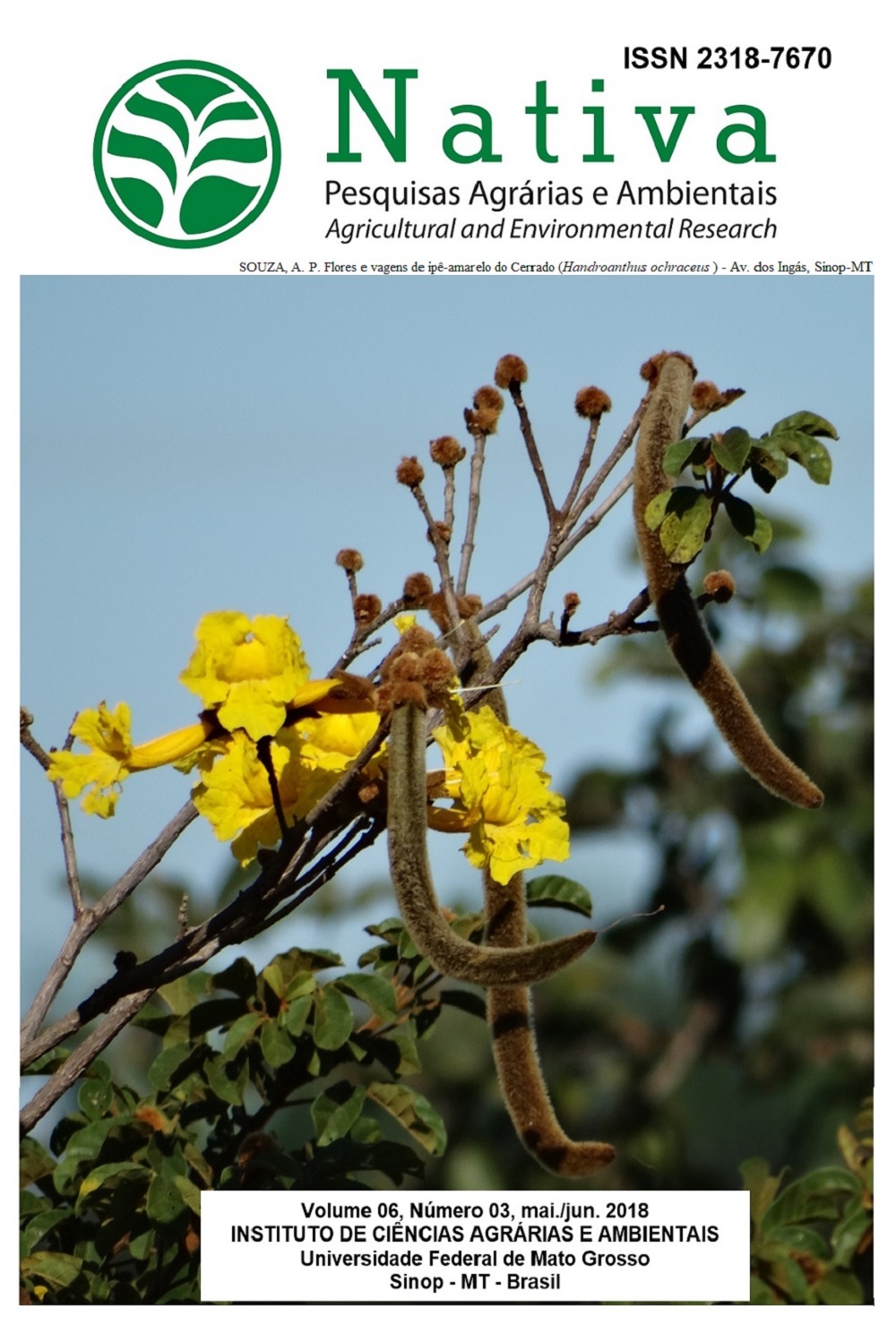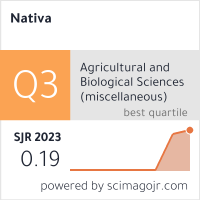TÉCNICAS DE TRANSFORMAÇÃO E LINHAGENS De Agrobacterium rhizogenes NA PRODUÇÃO DE HAIRY ROOTS DE Ocimum basilicum L.
DOI:
https://doi.org/10.31413/nativa.v6i3.5374Resumo
O manjericão é uma planta medicinal e seus metabólitos especiais são utilizados com fins terapêuticos e industriais. Este trabalho teve por objetivo avaliar técnicas e linhagens de Agrobacterium rhizogenes na produção de raízes transformadas de duas variedades de Ocimum basilicum L., Dark Opal (roxo) e Minete Anão (verde). Verificou-se o efeito da inoculação com linhagens de A. rhizogenes selvagens (A4, 8196, 9402, 2659, 2659 G, 17242, LBA, 15834) ou transformadas (R1601) em plantas inteiras ou explantes (folhas e segmentos de caule) de manjericão, cultivados em casa de vegetação ou in vitro. A inoculação com as linhagens LBA e 8196 possibilitou redução no número de explantes de folha de manjericão-verde oxidados, quando comparado ao controle. Dentre as linhagens selvagens, as que proporcionaram melhor indução na produção de raízes transformadas foram A4, LBA e 8196, respectivamente. Entretanto, a cepa R1601 apresentou a melhor resposta. Raízes foram eficientemente induzidas mediante a inoculação de explantes de manjericão-roxo e manjericão-verde e expressaram o fenótipo típico de raízes em cabeleira (hairy roots). As culturas clonais de manjericão-verde apresentaram rápido crescimento em meio de cultura livre de reguladores de crescimento.
Palavras-chave: agrobactéria, cultura de raízes, manjericão, plantas medicinais.
TRANSFORMATION TECHNIQUES AND Agrobacterium rhizogenes Strains In The Production Of Hairy Roots Of Ocimum basilicum L.
ABSTRACT:
Basil is a medicinal plant and its special metabolites are used for therapeutic or industrial purposes. The aim of this work was to evaluate Agrobacterium rhizogenes techniques and strains in the production of hairy roots of two varieties of Ocimum basilicum L., Dark Opal (purple) and Dwarf Racer (green). The effects of inoculation of A. rhizogene (A4, 8196, 9402, 2659, 2659, 2659 G, 17242, LBA, 15834) or (R1601) lines on whole plants or explants (leaves and stem segments) of basil, grown in a greenhouse or in vitro, in the production of hairy roots and calluses made by subcultures. Inoculation with the LBA and 8196 lines allowed a reduction in the number of oxidized basil-green leaf explants when compared to the control. Among the wild strains, those that had best ability to induce hairy root of hairy roots were A4, LBA and 8196, respectively. However, the R1601 laboratory strain had the best response. Roots were efficiently induced by the inoculation of explants basil-purple and basil-green and expressed the typical phenotype of hairy roots. Green-basal clonal cultures showed rapid growth in culture medium free of growth regulators.
Keywords: agrobacterim, basil, medicinal plants, root culture.
Referências
ATANASOV, A. G.; WALTENBERGER, B.; PFERSCHY-WENZIG, E. M.; LINDERD, T.; WAWROSCHA, C.; UHRINE, P.; TEMMLF, V.; WANGA, L.; SCHWAIGERB, S.; HEISSA, E. H.; et al. Discovery and resupply of pharmacologically active plant-derived natural products: A review. Biotechnology Advances, v. 33, n. 8, p. 1582-1614, 2015. DOI: https://doi.org/10.1016/j.biotechadv.2015.08.001
BAIS, H. P.; WALKER, T. S.; SCHWEIZER, H. P.; VIVANCO, J. M. Root specific elicitation and antimicrobial activity of rosmarinic acid in hairy root cultures of Ocimum basilicum. Plant Physiology and Biochemistry, Paris, v. 40, p. 983-995, 2002. DOI: https://doi.org/10.1016/S0981-9428(02)01460-2
BHATTACHARYYA, N.; SINGH, H. R.; AGARWALA, N.; BHAGAWATI, P.; AHMED, G.; DAS, S. Agrobacterium mediated transfer of nptII and gus genes in Camellia assamica. Journal of Agricultural Biotechnology and Sustainable Development, Nigeria, v. 6, n. 2, p. 22-28, 2014. DOI: https://dx.doi.org/10.5897/JABSD2013.0218
BILAL, A.; JAHAN, N.; AHMED, A.; BILAL, S. N.; HABIB, S.; HAJRA, S. Phytochemical and pharmacological studies on Ocimum basilicum linn - a review. International Journal of Current Research and Review, Nagpur, v. 4 n. 23, p. 73-83, 2012.
BORGO, L.; MARUR, C. J.; VIEIRA, L. G. E. Effects of high proline accumulation on chloroplast and mitochondrial ultrastructure and on osmotic adjustment in tobacco plants. Acta Scientiarum. Agronomy, Maringá, v. 37, n. 2, p. 191-199, 2015. DOI: http://dx.doi.org/10.4025/actasciagron.v37i2.19097
CHENNI, M.; ABED, D. E.; RAKOTOMANOMANA, N.; FERNANDEZ, X.; CHEMAT, F. Comparative study of essential oils extracted from Egyptian basil leaves (Ocimum basilicum L.) using hydro-distillation and solvent-free microwave extraction. Molecules, Basel, v.21, n.1, p.113, 2016. http://dx.doi.org/10.3390/molecules21010113
CHHETRI, B. K.; ALI, N. A.; SETZER, W. N. A Survey of chemical compositions and biological activities of Yemeni aromatic medicinal plants. Medicines, Basel, v. 2, n .2, p. 67-92, 2015. DOI: http://dx.doi.org/10.3390/medicines2020067
CIAU-UITZ, R.; MIRANDA-HAM, M. L.; COELLO-COELLO, J.; CHÍ, B.; PACHECO, L. M.; LOYOLA-VARGAS, V. M. Indole alkaloid production by transformed and non-transformed root cultures of Catharanthus roseus. In Vitro Cellular & Developmental Biology – Plant, United States, v. 30, n. 1, p. 84-88, 1994. http://dx.doi.org/10.1007/BF02632126
COHEN, A.; KRENS, F. A. Genetic transformation in the breeding of flower bulbs. Floric. Ornam. Biotechnol., Isleworth, v. 6, p. 24-34, 2012.
CRAGG, G. M.; NEWMAN, D. J. Natural products: a continuing source of novel drug leads. Biochimica et Biophysica Acta, Amsterdam, v. 1830, n. 6, p. 3670-3695, 2013. DOI: https://doi.org/10.1016/j.bbagen.2013.02.008
FERREIRA, M. E.; GRATTAPAGLIA, D. Introdução ao uso de marcadores moleculares em análise genética. 2a. ed. Brasília: EMBRAPA CENARGEN, 1995. pp. 220.
FILOVÁ, A. Production of secondary metabolites in plant tissue cultures. Research Journal of Agricultural Science, Srinagar, v.46, n.1, p.236-245, 2014. http://www.rjas.ro/volume_detail/25
GAI, Q.Y.; JIAO, J.; LUO, M.; WEI, Z. F.; ZU, Y. G.; MA, W.; FU, J. Y. Establishment of hairy root cultures by Agrobacterium rhizogenes mediated transformation of Isatis tinctoria L. for the efficient production of flavonoids and evaluation of antioxidant activities. Plos One, San Francisco, v. 10, n. 3, 2015. e0119022. DOI: https://dx.doi.org/10.1371/journal.pone.0119022
GANGOPADHYAY, M.; DEWANJEE, S.; BHATTACHARYYA, S.; BHATTACHARYA, S. Effect of different strains of Agrobacterium rhizogenes and nature of explants on Plumbago indica hairy root culture with special emphasis on root biomass and plumbagin production. Natural Products Communications, Westerville, v. 5, n. 12, p. 1913-1916, 2010.
GEORGIEV, M. I.; AGOSTINI, E.; LUDWIG-MÜLLER, J.; XU, J. Genetically transformed roots: from plant disease to biotechnological resource. Trends in Biotechnology, Netherlands, v. 30, n. 10, p. 528–537, 2012. DOI: https://dx.doi.org/10.1016/j.tibtech.2012.07.001
KARUPPUSAMY, S. A review on trends in production of secondary metabolites from higher plants by in vitro tissue, organ and cell cultures. Journal of Medicinal Plants Research, Nigeria, v. 3, n. 13, p. 1222-1239, 2009.
KINGHORN, A. D.; PAN, L.; FLETCHER, J. N.; CHAI, H. The relevance of higher plants in lead compound discovery programs. Journal of Natural Products, Columbus, v. 74, n. 6, p. 1539-1555, 2011. DOI: http://dx.doi.org/10.1021/np200391c
MAHESH, A.; JEYACHANDRAN, R. Agrobacterium rhizogenes mediated hairy root induction in Taraxacum officinale and analysis of sesquiterpene lactones. Plant Biosystems, Bologna, v. 145, n. 3, p. 620-626, 2011. DOI: http://dx.doi.org/10.1080/11263504.2011.584702
MALLOL, A.; CUSIDÓ, R. M.; PALAZÓN, J.; BONFILL, M; MORALES, C.; PIÑOL, M. T. Ginsenoside production in different phenotypes of Panax ginseng transformed roots. Phytochemistry, NY, v. 57, p. 365-371. 2001. DOI: https://doi.org/10.1016/S0031-9422(01)00062-0
MURASHIGE T.; SKOOG F. A. A revised medium for a rapid growth and bioassays with Tobacco tissues cultures. Physiologia Plantarum, København, v. 15, n. 7, p. 473-479, 1962. DOI: http://dx.doi.org/10.1111/j.1399-3054.1962.tb08052.x
NESTER, E. W. Agrobacterium: Nature’s genetic engineer. Frontiers in Plant Science, Switzerland, v. 5, p. 730, 2015. DOI: https://dx.doi.org/10.3389/fpls.2014.00730
NYABOGA, E.; TRIPATHI, J. N.; MANOHARAN, R.; TRIPATHI, L. Agrobacterium-mediated genetic transformation of yam (Dioscorea rotundata): an important tool for functional study of genes and crop improvement. Frontiers in Plant Science, Switzerland, v. 5, p. 463. 2015. DOI: https://dx.doi.org/10.3389/fpls.2014.00463
PEREIRA, G. A; CORREA, L. S.; BOLIANI, A. C. Desinfestação e estabelecimento in vitro de explantes de bananeira ‘Grande Naine’ em diferentes concentrações de hipoclorito de sódio. Revista Brasileira de Fruticultura, Jaboticabal, v. 33, n. Especial, p. 222-226, 2013. DOI: http://dx.doi.org/10.1590/S0100-29452011000500026
SARAVANAKUMAR, A.; ASLAM, A.; SHAJAHAN, A. Development and optimization of hairy root culture systems in Withania somnifera (L.) Dunal for withaferin-A production. African Journal of Biotechnology, Nairobi, v. 11, n. 98, p. 16412-16420, 2012. DOI: https://doi.org/10.5897/AJB11.3867
SETAMAM, N. M.; SIDIK, N. J.; RAHMAN, Z. A.; ZAIN, C. R. C. M. Induction of hairy roots by various strains of Agrobacterium rhizogenes in different types of Capsicum species explants. BMC Research Notes, London, v. 7, p. 414-421, 2014. DOI: https://doi.org/10.1186/1756-0500-7-414.
SRIVASTAVA, S; CONLAN, X. A.; ADHOLEYA, A; CAHILL, D. M. Elite hairy roots of Ocimum basilicum as a new source of rosmarinic acid and antioxidants. Plant Cell, Tissue and Organ Culture. Berlin, v. 126, n. 1, p. 19-32, 2016. DOI: http://dx.doi.org/10.1007/s11240-016-0973-x
TADA, H.; MURAKAMI, Y; OMOTO, T.; SHIMOMURA, K.; ISHIMARU, K. Rosmarinic acid and related phenolics in hairy root cultures of Ocimum basilicum. Phytochemistry, NY, v. 42, n. 2, p. 431-434, 1996. DOI: https://doi.org/10.1016/0031-9422(96)00005-2
THWE, A.; ARASU, M. V.; LI, X.; PARK, C. H.; KIM, J. S.; Al-DHABI, N. A.; PARK, S. U. Effect of Different Agrobacterium rhizogenes strains on hairy root induction and phenylpropanoid biosynthesis in tartary buckwheat (Fagopyrum tataricum G.). Frontiers in Microbiology, Lausanne, v. 7, n. 318, 2016. DOI: http://dx.doi.org/10.3389/fmicb.2016.00318.
YU, S.; KWOK, K. H.; DORAN, P. M. Effect of sucrose, exogenous product concentration, and other culture conditions on growth and steroidal alkaloid production by Solanum aviculare hairy roots. Enzyme and Microbial Technology, NY, v. 18, n. 4, p. 238-243, 1996. DOI: https://doi.org/10.1016/0141-0229(95)00057-7
ZAHANIS, Z.; MANSYURDIN, M.; NOLI, Z. A.; BACHTIAR, A. Induction of hairy roots of Pegagan (Centella asiatica L.) urban using several explant sources with several Agrobacterium rhizogenes strains in vitro. International Journal on Advanced Science, Engineering and Information Technology, Indonesian, v. 4, n. 4, p. 286-289, 2014. DOI: http://dx.doi.org/10.18517/ijaseit.4.4.418
Downloads
Publicado
Edição
Seção
Como Citar
Licença
Direitos Autorais para artigos publicados nesta revista são do autor, com direitos de primeira publicação para a revista. Em virtude de a aparecerem nesta revista de acesso público, os artigos são de uso gratuito, com atribuições próprias, em aplicações educacionais e não-comerciais.
A artigos publicados nessa revista, podem ser reproduzidos parcialmente ou utilizados como referência por outros autores, desde que seja cita a fonte, ou seja, a Revista Nativa.
Copyright for articles published in this journal are the authors, with first publication rights granted to the journal. The journal shows open access, and articles are free to use, with proper attribution, in educational and non-commercial.
The articles published in this journal may be reproduced in part or used as a reference by other authors, provided that the source is quoted.






